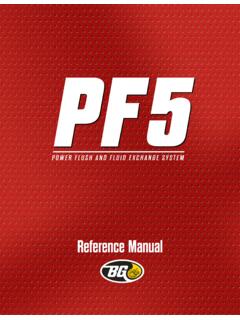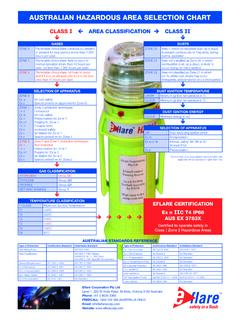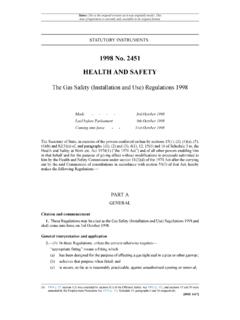Transcription of FILLING AND PURGING THE SYSTEM - Seatech Marine …
1 Outboard Powered Vessels35 FILLING AND PURGING THE SYSTEMRead FirstThese instructions show how to fill and purge a Single Station Front Mount Cylinder SYSTEM . For twin station and/or twin cylinder FILLING and PURGING instructions refer to instructions on page 39 first and then proceed with instructions on this procedure requires two people. One person may not be able to remove all the air from the SYSTEM which will result in spongy, unresponsive the entire FILLING procedure, oil must be visible in the filler tube. DO NOT allow the oil level to disappear into the helm pump, as this may introduce air into the SYSTEM and increase your FILLING using a Liquid Tie bar Valve, part # HA5471-2, please refer to the bleeding instructions included with the liquid tie bar Oil Requirements2 bottles (2 quarts or liters) for single station and single cylinder additional bottle for each additional helm, cylinder, or auto pilot.
2 Oil can be re-used if filtered through a fine mesh screen such as used for gasoline. If unable to filter oil, an additional bottle of oil is required. Bleeder may refer to cylinders fitted with bleed tee fittings or bleed screws. If fitted with bleed tee fitting, open bleeder by unscrewing bleed nipple nut two PLUG(REMOVED)FILLER KITHELM FILLPORTDO NOT LET OIL LEVEL FALL BELOWTHIS POINTPUSH PINNOTICENOTICENOTICEF illing the helm full of oil can be done faster if oil is poured into the helm prior to connecting filler tube and oil bottle to the helm. Part # SYSTEM is fitted with SeaStar Power Assist, please refer to your Power Assist Installation Manual for bleeding the following pages you are instructed to hold cylinder body with your hand, if the cylinder is mounted to an engine, use the engine to hold the body in 36.
3 Optional Filler Kit Part # HA543836 SEASTAR HydraulicsFILLING AND PURGINGVENT PLUG - Part No. HP6126 SUPPLIED WITH SEASTAR HELM PUMP MUST BE USED WITH HELM PUMP ON ALL SINGLE STEERING STATION SYSTEMS. MUST BE USED ON UPPERMOST HELM PUMP ON MULTI STEERING STATION PLUG - Part No. HP6000 MUST BE USED ON ALL HELM PUMPS OTHER THAN UPPER MOST HELM PUMP ON MULTI STEERING STATION SYSTEMS. THIS NON-VENT PLUG IS SUPPLIED WITH ADDITIONAL STATION FITTING KIT NO. HF5501 AND FluidFill Plugs for SeaStar HelmsHYDRAULIC STEERINGDue to recent upgrades in our steering SYSTEM components, SeaStar Solutions recommends use of SeaStar Steering Fluid ONLY in our hydraulic steering systems.
4 SeaStar Steering Systems have been engineered and validated using our proprietary SeaStar Hydraulic Steering Fluid. SeaStar Steering fluid is engineered with special additive package that contains anti-foaming and anti-rusting agents, anti-oxidants, viscosity stabilizers, corrosion inhibitors, wear additives as well as water emulsification additives. It is highly recommend that SeaStar Steering Fluid be used to ensure optimum SYSTEM performance and an emergency, SeaStar EPS Fluid, any MD-3/4 rated ATF or MIL-PRF-5606H equivalent fluid that is filtered through a fine mesh screen can be used. The SYSTEM MUST be thoroughly flushed as soon as possible with genuine SeaStar Steering Fluid after using an emergency an EXTREME emergency, any non-toxic, non-flammable fluid that is filtered through a fine mesh screen may provide temporary NON-APPROVED FLUID MAY CAUSE SERIOUS DAMAGE TO THE STEERING SYSTEM RESULTING IN POSSIBLE LOSS OF STEERING, CAUSING PROPERTY DAMAGE, PERSONAL INJURY AND/OR Hydraulic Steering Fluid can be used in Hynautic, BayStar and BayStar Plus steering protect your boating environment by ensuring that all used oil is disposed of of any non-approved fluid may result in the following.
5 Higher steering effort, particularly at ambient or lower temperatures and/or over time due to oil degradation and breakdown increased steering slip and/or drift resulting in lost motion foaming or air entrapment causing a bumpy feel during steering high rates of moisture absorption causing internal component corrosion scratched steering cylinder bores and shafts due to contamination or elevated wear rates seal degradation incompatibility with various proprietary seal compounds used in our of non-standard fluids will require an immediate and complete SYSTEM flush using approved fluids, by an approved steering FILL OR MIX BRAKE FLUIDS, TRIGYCERIDES OR POLYALKYLENE GLYCOLS WITHIN A HYDRAUILIC STEERING WARNING WARNINGO utboard Powered Vessels37 Step 3 Holding the cylinder body (Front Mount cylinder) or rod (Side Mount cylinder) to prevent the body/rod from moving, turn the steering wheel counter-clockwise until a steady stream of air free oil comes out of the bleeder.
6 (Drain approx. 1/2 bottle of oil or as required). DO NOT use anything other than your hands to restrain the cylinder body/rod. While continuing to turn the wheel close the right side bleeder and let go of the cylinder COUNTER-CLOCKWISECLOSE RIGHT SIDE BLEEDERFRONT MOUNT CYLINDERStep 2 Step 1 Single Station One CylinderOPEN RIGHT SIDE BLEEDERTURN CLOCKWISEFRONT MOUNT CYLINDER Screw the threaded end of the filler tube into the helm filler port. Remove the cap from the oil bottle and holding upright screw into the filler tube bottle cap. Poke hole in the bottom of the bottle. Fill the helm pump full of hydraulic oil so that it is visible in the filler tube. Oil should always be visible in the filler tube.
7 Use the next bottle of fluid at any time during the procedure in order to maintain the oil level. DO NOT proceed with step two until helm is full. Turn the steering wheel clockwise until the cylinder rod is fully extended on the right side of the cylinder. Open right side BOTTLEFILLER TUBEHELMSTEERING WHEELFRONT MOUNT CYLINDERFRONT MOUNT CYLINDER38 SEASTAR HydraulicsFILLING AND PURGINGHYDRAULIC STEERINGStep 4 Continue turning the steering wheel counter-clockwise until the cylinder rod is fully extended to the left. (Steering wheel will come to a stop). Open the left COUNTER-CLOCKWISEOPEN LEFT SIDE BLEEDERFRONT MOUNT CYLINDERN umber of Steering Wheel TurnsStep 5 TURN CLOCKWISECLOSE LEFT SIDE BLEEDERFRONT MOUNT CYLINDERHelm Single Twin Cylinder with Twin Cylinder with Displacement Cylinder Mechanical Tiebar Liquid Tiebar steering SYSTEM has been properly bled, steering wheel turns from hard over to hard over will be as shown in the chart.
8 CAUTIONP rior to operating SYSTEM , perform Oil Level SYSTEM Check, refer to page 40. Holding the cylinder body (Front Mount cylinder) or rod (Side Mount cylinder) to prevent the body/rod from moving, turn the steering wheel clockwise until a steady stream of air free oil comes out of the bleeder. While continuing to turn the wheel close the left side bleeder and let go of the cylinder Powered Vessels39 CYLINDER steps 1 through 5 at station no. 1. Then repeat steps 1-5 at station no. 2. Oil requirements 4-5 : Refer to Oil Level and SYSTEM Check page properly bled, steering wheel turns will be as shown in the performing steps 1 through 5, perform instructions in each step first on cylinder no.
9 1 and then on cylinder no. 2, before proceeding to the next step. ie: Perform instructions referring to right side of cylinder first on cylinder no. 1 and then on cylinder no. requirements 4- 5 : Refer to Oil Level and SYSTEM Check on page 40. Steering wheel turns will be as shown in the Station Single Cylinder Single Station Twin Cylinder STATION same procedure as instructed for single station-twin cylinders, beginning at station no. 1, and repeat entire procedure at station no. : When properly bled, steering wheel turns will be as shown in the Station Twin Cylinder CYLINDER HydraulicsThe oil level MUST be checked and maintained BEFORE EACH use to ensure safe steering operation.
10 Failure to adhere to this warning may lead to loss of steering control resulting in persons being ejected from vessel or collision with an obstacle, leading to property damage, personal injury and/or death. For helms mounted with the wheel shaft completely horizontal MUST be filled to the bottom of filler hole AT ALL TIMES. DO NOT allow oil level to drop more than 1/4 below filler threads. For helms mounted on a 20 degree angle, or, with wheel shaft in the vertical position, oil level should be within 1/2 from the bottom of the filler the helm is overfilled fluid WILL leak out of the vent SYSTEM check MUST be completed after installation. Doing so will ensure the safe operation of your steering SYSTEM and will any fault/leak will show at this time.




